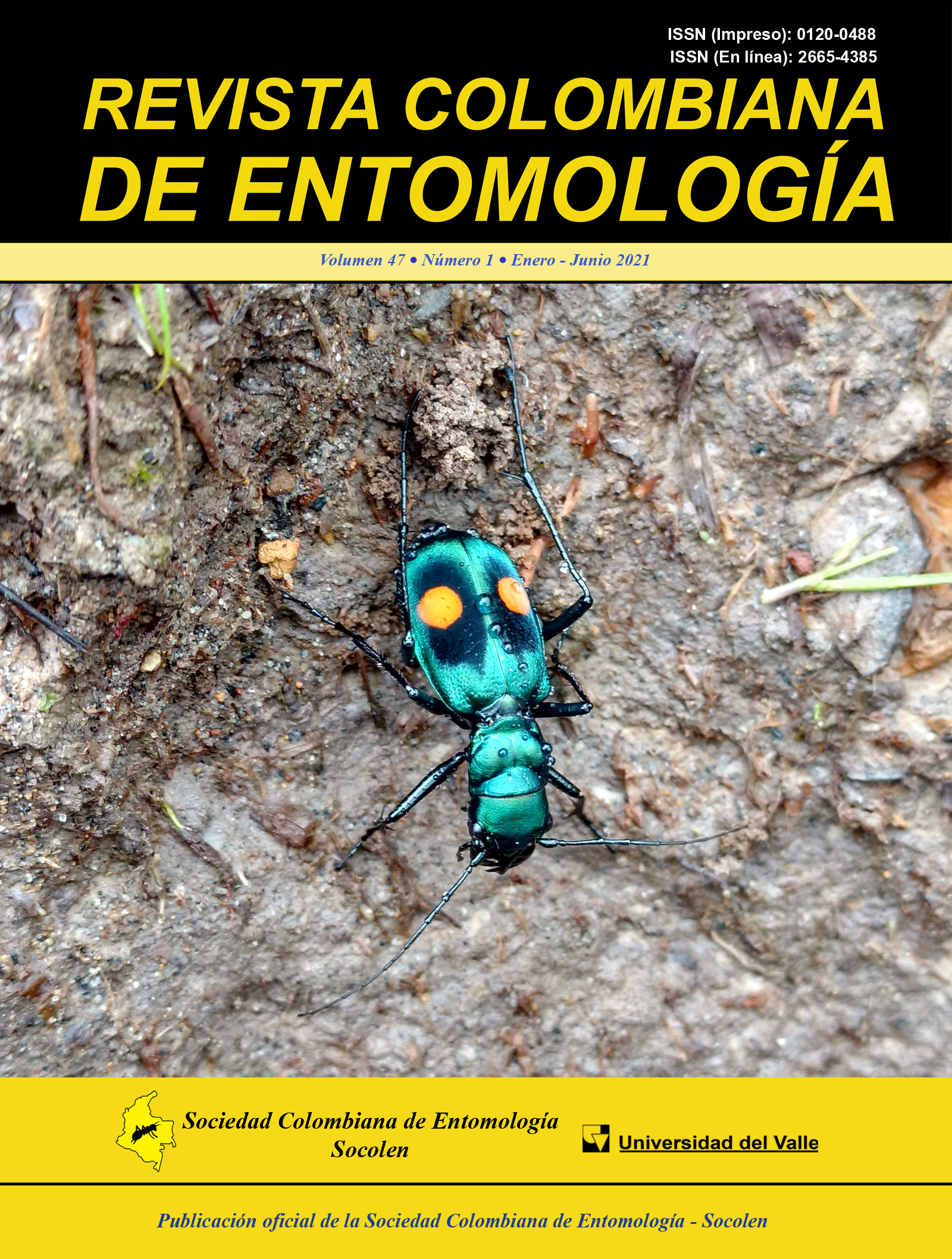Incidence of pests in post-harvest material of nine export-type hydrangea cultivars in Antioquia (Colombia)
Keywords:
Hydrangea spp., Integrated Pest Management, Floriculture, Quarantine pests, Arthropods, Interception, ColombiaMain Article Content
Floriculture in Colombia has great economic and social impact bringing important profit to the sector for more than 40 years. Recently, the hydrangeas flower market have the largest growths in cultivated areas and exported product, but they also have the highest rates of interceptions at the international ports. Even so, few information about the main pests affecting crops, areas or cultivars has been published. This study evaluated the pests captured on hydrangeas’ flowers inspected in a trading company of the Eastern region of Antioquia. A total of 6,272 samples (31,360 flowers), of nine cultivars from 86 farms in six municipalities collected during five months were used. The 8.61 % of the samples had at least one limiting-pest specimen for exportation. The most frequent arthropods were mites, eggs and motile stages, and in less frequency aphids, thrips and slugs. The most affected cultivars were those with blue flowers. The 90 % of the farms (n = 86) had at least one event of interception, although there was no spatial pattern associated with municipality. Our data suggest that the interceptions by quarantine pests were associated with the crop and post-harvest management rather than their geographic location or cultivars. This work provides, for the first time, information of the pests with highest incidence in exporting-type Hydrangeas. Although there is no information about the incidence of hydrangeas pests in the crops, these results could help to identify priority areas and cultivars for inspection and evaluation in the field.
AKAIKE, H. 1974. A new look at the statistical model identification. IEEE Transactions on Automatic Control 19 (6): 716-723. https://doi.org/10.1109/TAC.1974.1100705
ARBELÁEZ, G. 1993. La floricultura colombiana de exportación. Agronomía Colombiana 10 (1): 5-11. https://revistas.unal.edu.co/index.php/agrocol/article/view/21224/22205
ARÉVALO P., E.; QUINTERO F., O. X.; CORREA L., G. 2003. Reconocimiento de trips (Insecta: Thysanoptera) en floricultivos de tres corregimientos del municipio de Medellín, Antioquia (Colombia). Revista Colombiana de Entomología 29 (2): 169-175. http://www.scielo.org.co/pdf/rcen/v29n2/v29n2a09.pdf
FOOD AND AGRICULTURE ORGANIZATION OF THE UNITED NATIONS (FAO). 2002. Aplicación de medidas integradas en un enfoque de sistemas para el manejo del riesgo de plagas. Food and Agriculture Organization of the United Nations. http://www.fao.org/3/a-y4221s.pdf
HAMMER, Ø.; HARPER, D. A. T.; RYAN, P. D. 2001. PAST: Paleontological statistics software package for education and data analysis, 178 kb. Palaeontologia Electronica 4 (1): 1-9. https://palaeo-electronica.org/2001_1/past/issue1_01.htm https://palaeo-electronica.org/2001_1/past/past.pdf
INSTITUTO COLOMBIANO AGROPECUARIO (ICA). 2018a. El ICA apoya el florecimiento del sector ornamental de Antioquia. Instituto Colombiano Agropecuario, marzo. Disponible en: https://www.ica.gov.co/noticias/ica-apoya-exportacion-ornamental-antioquia [Fecha revisión: julio 2018]
INSTITUTO COLOMBIANO AGROPECUARIO (ICA). 2018b. Lista de empresas exportadoras y predios productores de ornamentales de exportación. SISFITO, Antioquia. Instituto Colombiano Agropecuario. Disponible en: https://sisfito.ica.gov.co/reportes/reporte_inicio_I.php [Fecha revisión: mayo 2018]
INSTITUTO COLOMBIANO AGROPECUARIO (ICA). 2020. Polillas y otros artrópodos de atención prioritaria para los productores de hortensia ( Hydrangea spp.). Alerta temprana fitosanitaria Boletín No 18, Subgerencia de Protección Vegetal del ICA, Agosto 2020. https://www.ica.gov.co/getattachment/ICAComunica/alertasfito/ALERTA_TEMPRANA_HORTENSIA_06082020.pdf.aspx?lang=es-CO [Fecha revisión: agosto 2020]
KAKAR, H.; IQBAL, A.; KAMRAN, K.; ARIF, S.; SHAHEEN, U.; KAMRAN TAJ, M.; SAMAD, A.; SHAHABUDDIN.; AHMED ESSOTE, S.; ALAM, R.; ALI, A. 2017. Morphometric study of Tetranychus urticae (Acariformes: Tetranychidae) in Ziarat district, Baluchistan, Pakistan. International Journal of Biosciences 10 (1): 401-407. https://dx.doi.org/10.12692/ijb/10.1.401-407
MINISTERIO DE AGRICULTURA Y DESARROLLO RURAL (MINAGRICULTURA). 2020. Cadena de flores. Dirección de Cadenas Agrícolas y Forestales, Ministerio de Agricultura y Desarrollo Rural, Febrero 2020. https://sioc.minagricultura.gov.co/Flores/Documentos/2019-12-30%20Cifras%20Sectoriales.pdf [Fecha revisión: agosto 2020]
OSORIO SOTO, G.; VILLA CASTRO, J.; ARREDONDO URREGO, J.; VÁSQUEZ MARTÍNEZ, J.; RESTREPO OSPINA, J.; RESTREPO MEJÍA, L.; JARILLO GIL, W. 2015. Manual técnico del cultivo de hortensias de exportación bajo buenas prácticas agrícolas. Medellín, Colombia, 130 p.
RHAINDS, M.; DOYON, J.; RIVOAL, J.; BRODEUR, J. 2007. Thrips‐induced damage of chrysanthemum inflorescences: evidence for enhanced leakage of carotenoid pigments. Entomologia Experimentalis et Applicata 123 (3): 247-252. https://doi.org/10.1111/j.1570-7458.2007.00543.x
SIMBAQUEBA, R.; SERNA, F.; POSADA-FLÓREZ, F. J. 2014. Curaduría, morfología e identificación de áfidos (Hemiptera: Aphididae) del Museo Entomológico Unab. Primera Aproximación. Boletín Científico Centro de Museos de Historia Natural 18 (1): 222-246. http://www.scielo.org.co/pdf/bccm/v18n1/v18n1a17.pdf
TENJO G., F.; MONTES U., E.; MARTÍNEZ T., J. 2006. Comportamiento reciente (2000-2005) del sector floricultor colombiano. Colombia. 22 p. http://www.banrep.gov.co/docum/ftp/borra363.pdf
VALCÁRCEL-CALDERÓN, F. 2013. El control biológico de plagas en la floricultura colombiana. Simposio 6 "Plagas de las flores" En: Rueda-Ramírez, D.; Torrado-León, E.; Becerra, E. H. (Comp.). Libro de memorias. 40 Congreso Socolen. Bogotá, D.C., 10, 11 y 12 de julio de 2013. Sociedad Colombiana de Entomología. CD-ROM. Bogotá, D. C., 445 p. http://www.socolen.org.co/images/stories/pdf/40_Congreso.pdf
Downloads

This work is licensed under a Creative Commons Attribution-NonCommercial-ShareAlike 4.0 International License.
Authors retain the copyright on their work and are responsible for the ideas expressed in them. Once a manuscript is approved for publication, authors are asked for a publication license for the term of legal protection, for all territories that allows the use, dissemination and disclosure of the same.

